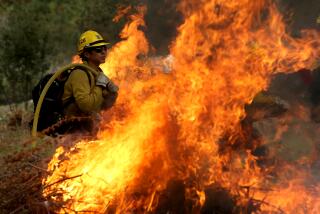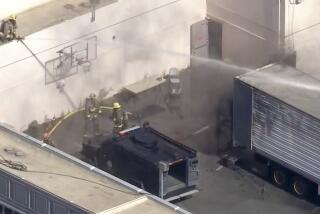Station fire’s strength was miscalculated

U.S. Forest Service officials underestimated the threat posed by the deadly Station fire and scaled back their attack on the blaze the night before it began to rage out of control, records and interviews show.
In response to Times inquiries, officials for the Forest Service and Los Angeles County Fire Department said they probably will change their procedures so that the two agencies immediately stage a joint assault on any fire in the lower Angeles National Forest.
Angeles Forest Fire Chief David Conklin said his staff was confident that the Station fire had been “fairly well contained” on the first day, so it decided that evening to order just three water-dropping helicopters to hit the blaze shortly after dawn on its second day -- down from five on Day One -- and prepared to go into mop-up mode with fewer firefighters on the ground.
The Forest Service realized overnight that three helicopters would not be enough, and brought in two more later in the morning, Conklin said. More engine companies and ground crews were also summoned, but it would prove too late.
“We felt we had sufficient resources,” Conklin said. “There’s always that lesson. We’ll always have that in the back of our minds.”
On the second day of the blaze, which started Aug. 26, the county Fire Department lent the Forest Service a heli-tanker but denied its request for another smaller chopper. Chief Deputy John Tripp, the No. 2 official in the department, said he made that decision because he did not believe the fire was endangering neighborhoods near its suspected ignition point above La Canada Flintridge, and because the county must hold on to some helicopters for other emergencies. Helicopters are often key to corralling wildfires early on.
“If there was a threat that morning to the community of La Canada . . . we would have dispatched more helicopters,” Tripp said.
In the future, he said, setting up a joint command with the Forest Service as soon as a fire breaks out -- including possibly at high elevations -- should make it easier for the agencies to muster each other’s helicopters, engines and ground crews. Currently, joint commands are established only if a blaze presents an imminent threat to foothill communities.
“We have to be that much more robust in our response,” Tripp said. “That’s what, on a personal note, I have learned from this.”
On the first day, the Forest Service expected that the Station fire could be controlled by the following afternoon, with no buildings lost and with minimal harm to the natural treasures of the San Gabriel Mountains, according to documents and officials.
By nightfall on Day Two, the fire was burning nearly unchecked into the forest, despite low winds. The conflagration would become the largest in the county’s recorded history, blackening more than 160,000 acres of chaparral and centuries-old trees, destroying dozens of dwellings and killing two county firefighters who died when their truck fell off a mountain road.
The county department bolstered the Forest Service’s first-day response in the belief that the fire imperiled county territory. The county sent five helicopters -- one a command ship that directs the drops -- five engines and four hand crews, officials said. Once it became clear that the fire was within the Forest Service’s jurisdiction, the officials said, the county was required to await requests from the federal agency for help on subsequent days.
A veteran county fire official who took part in the first day’s battle said he was disheartened that his department was not brought back at similar strength the next morning.
“There was a real window of opportunity that wasn’t recognized or acted on,” said the official, who requested anonymity because he was not authorized to discuss the matter. “Every brush fire starts out small. Either you extinguish the damn thing or it goes a few days and you have a major disaster.”
Conklin said that, after the county rejected the request for the second chopper on Day Two, the Forest Service began diverting helicopters from a fire near Morris Dam in the San Gabriels. It also ordered a heli-tanker from the Los Angeles Fire Department, officials said.
City Fire Capt. Steve Ruda said his department had more helicopters available on the second day. “I can’t tell you why they weren’t needed . . . why they didn’t ask for the city birds,” he said.
The state Department of Forestry and Fire Protection also had helicopters on hand but was asked only for a tactical observation plane on the first two days of the Station fire, according to officials.
“They didn’t really hit us up for heavy resources until the morning of the third day,” said Janet Upton, spokeswoman for the state agency.
As the morning of Day Two unfolded, the fire spread up and down a steep canyon, and ground crews had trouble safely confronting it, officials said. “You just couldn’t put people down-slope to fight that fire,” Conklin said.
The Forest Service called in several more helicopters as well as heavy air tankers, but the fire already was multiplying in size, he said.
Some residents of the fire zone said they were baffled by the diminished air assault after sunup the second day.
“There were some decisions made that I would love to know,” said Adi Ell-Ad, who lost his Big Tujunga Canyon home to the fire. “We really haven’t gotten answers. We want to know what happened.”
The suspected arson fire broke out at 3:20 p.m. on a Wednesday along Angeles Crest Highway. It took its name from the nearby Angeles Crest Ranger Station.
According to a Forest Service summary of the first day, the fire had been kept to 15 acres and was expected to be controlled by 1 p.m. the next day.
The summary is detailed in a document called an Incident Command System 209. The forms are snapshots of an emergency response and thus can convey inaccurate tallies of equipment and personnel over a longer period of time, especially when more than one agency is involved. The first 209 for the Station fire, for instance, does not include the five county helicopters that officials say were sent on Day One.
The 209 for the morning of the second day says the fire had grown to 40 acres, and threatened two ranger stations, an outdoor school, homes in the Arroyo Seco area and NASA’s Jet Propulsion Laboratory. It also lists as “critical resource needs” more helicopters, engines and ground crews.
But the morning summary still estimated that the blaze would be contained within three days, by Aug. 30, and it noted that the total number of personnel on the line -- from the Forest Service, county and other agencies -- had been reduced to 191 from 231 the day before.
An evening 209 for the second day is more dire. It says that the fire had swelled to 500 acres, that 510 firefighters were at the scene, and that the critical needs included heavy air tankers, in addition to more helicopters, engines and ground crews.
Even so, the document pushed back the expected containment time by just two days -- to Sept. 1.
The fire is still burning.
--
paul.pringle@latimes.com
More to Read
Start your day right
Sign up for Essential California for news, features and recommendations from the L.A. Times and beyond in your inbox six days a week.
You may occasionally receive promotional content from the Los Angeles Times.







